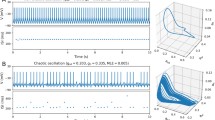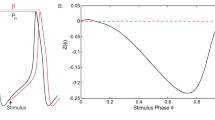Abstract.
We study weakly connected networks of neural oscillators near multiple Andronov-Hopf bifurcation points. We analyze relationships between synaptic organizations (anatomy) of the networks and their dynamical properties (function). Our principal assumptions are: (1) Each neural oscillatorcomprises two populations of neurons: excitatory and inhibitory ones; (2) activity of each population of neurons is described by a scalar (one-dimensional) variable; (3) each neural oscillatoris near a nondegenerate supercritical Andronov-Hopf bifurcation point; (4) the synaptic connections between the neural oscillatorsare weak. All neural networks satisfying these hypotheses are governed by the same dynamical system, which we call the canonical model. Studying the canonical model shows that: (1) A neural oscillatorcan communicate only with those oscillators which have roughly the same natural frequency. That is, synaptic connections between a pair of oscillators having different natural frequencies are functionally insignificant. (2) Two neural oscillatorshaving the same natural frequencies might not communicate if the connections between them are from among a class of pathological synaptic configurations. In both cases the anatomical presence of synaptic connections between neural oscillators does not necessarily guarantee that the connections are functionally significant. (3) There can be substantial phase differences (time delays) between the neural oscillators, which result from the synaptic organization of the network, not from the transmission delays. Using the canonical model we can illustrate self-ignition and autonomous quiescence (oscillator death) phenomena. That is, a network of passive elements can exhibit active properties and vice versa. We also study how Dale's principle affects dynamics of the networks, in particular, the phase differences that the network can reproduce. We present a complete classification of all possible synaptic organizations from this point of view. The theory developed here casts some light on relations between synaptic organization and functional properties of oscillatory networks. The major advantage of our approach is that we obtain results about all networks of neural oscillators, including the real brain. The major drawback is that our findings are valid only when the brain operates near a critical regime, viz. for a multiple Andronov-Hopf bifurcation.
Similar content being viewed by others
Author information
Authors and Affiliations
Additional information
Received: 25 April 1995 / Accepted in revised form: 16 April 1996
Rights and permissions
About this article
Cite this article
Hoppensteadt, F., Izhikevich, E. Synaptic organizations and dynamical properties of weakly connected neural oscillators . Biol Cybern 75, 117–127 (1996). https://doi.org/10.1007/s004220050279
Issue Date:
DOI: https://doi.org/10.1007/s004220050279




